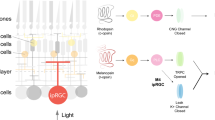Abstract
The compound eye of Pieris rapae crucivora contains ventrally three types of histologically distinct ommatidia. An ommatidium contains nine photoreceptors, four of which (R1–4) construct the distal tier of the rhabdom. We determined the sensitivity spectra of the R1–4 distal photoreceptors in each type of ommatidia by intracellular electrophysiology and identified UV, blue, double-peaked blue, green, and a green receptor with depressed sensitivity in the violet. We localized these receptors in each type of ommatidia by injecting dye after the recording. In type I ommatidia the R1 and R2 cells are UV and blue receptors. When R1 is UV sensitive, R2 is always blue sensitive, or vice versa. R3 and R4 in type I are both green receptors. In type II, R1 and R2 are both double-peaked blue receptors and R3 and R4 are both green receptors with depressed sensitivity in the violet. In type III, R1 and R2 are both UV, and R3 and R4 are green receptors. The double-peaked blue, and green receptors with depressed sensitivity in the violet in type II ommatidia have depressed sensitivity at 420 nm, which is probably due to the filtering effect of a fluorescing material present in the type II ommatidia. Spectral heterogeneity of ommatidia seems to be a common design of insect compound eyes.






Similar content being viewed by others
Abbreviations
- B:
-
blue
- dB:
-
double-peaked blue
- dG:
-
green receptors with depressed sensitivity in the violet
- G:
-
green
References
Arikawa K, Stavenga DG (1997) Random array of colour filters in the eyes of butterflies. J Exp Biol 200:2501–2506
Arikawa K, Mizuno S, Scholten DGW, Kinoshita M, Seki T, Kitamoto J, Stavenga DG (1999a) An ultraviolet absorbing pigment causes a narrow-band violet receptor and a single-peaked green receptor in the eye of the butterfly Papilio. Vision Res 39:1–8
Arikawa K, Scholten DGW, Kinoshita M, Stavenga DG (1999b) Tuning of photoreceptor spectral sensitivities by red and yellow pigments in the butterfly Papilio xuthus. Zool Sci 16:17–24
Goulson D, Cory JS (1993) Flower constancy and learning in foraging preferences of the green-veined white butterfly Pieris napi. Ecol Entomol 18:315–320
Kandori I, Ohsaki N (1996) The learning abilities of the white cabbage butterfly, Pieris rapae, foraging for flowers. Res Popul Ecol 38:111–117
Kitamoto J, Sakamoto K, Ozaki K, Mishina Y, Arikawa K (1998) Two visual pigments in a single photoreceptor cell: identification and histological localization of three mRNAs encoding visual pigment opsins in the retina of the butterfly Papilio xuthus. J Exp Biol 201:1255–1261
Kitamoto J, Ozaki K, Arikawa K (2000) Ultraviolet and violet receptors express identical mRNA encoding an ultraviolet-absorbing opsin: identification and histological localization of two mRNAs encoding short-wavelength-absorbing opsins in the retina of the butterfly Papilio xuthus. J Exp Biol 203:2887–2894
Kolb G (1978) Zur Rhabdomstruktur des Auges von Pieris brassicae L. (Insecta, Lepidoptera). Zoomorphologie 91:191–200
Kolb G, Scherer C (1982) Experiments on wavelength specific behavior of Pieris brassicae L. during drumming and egg-laying. J Comp Physiol A 149:325–332
Obara Y, Hidaka T (1968) Recognition of the female by the male, on the basis of ultra-violet reflection, in the white cabbage butterfly, Pieris rapae crucivora Boisduval. Proc Jpn Acad 44:829–832
Qiu X, Vanhoutte KAJ, Stavenga DG, Arikawa K (2002) Ommatidial heterogeneity in the compound eye of the male small white butterfly, Pieris rapae crucivora. Cell Tissue Res 307:371–379
Ribi WA (1978) Ultrastructure and migration of screening pigments in the retina of Pieris rapae L. (Lepidoptera, Pieridae). Cell Tissue Res 191:57–73
Scherer C, Kolb G (1987) Behavioral experiments on the visual processing of color stimuli in Pieris brassicae L. (Lepidoptera). J Comp Physiol A 160:645–656
Shimohigashi M, Tominaga Y (1991) Identification of UV, green and red receptors, and their projection to lamina in the cabbage butterfly, Pieris rapae. Cell Tissue Res 263:49–59
Stavenga DG (2002) Reflections on colourful ommatidia of butterfly eyes. J Exp Biol 205:1077–1085
Stavenga DG, Smits RP, Hoenders BJ (1993) Simple exponential functions describing the absorbance bands of visual pigment spectra. Vision Res 33:1011–1017
Acknowledgements
We thank Dr Doekele Stavenga for critical reading of the manuscript. X. Qiu is an International Scholarship Student of the Ministry of Education, Culture, Sports, Science, and Technology of Japan (MEXT) in the Graduate School of Integrated Science of Yokohama City University. The present work was supported by Grants-in-aid for scientific research from MEXT to K. Arikawa.
Author information
Authors and Affiliations
Corresponding author
Rights and permissions
About this article
Cite this article
Qiu, X., Arikawa, K. The photoreceptor localization confirms the spectral heterogeneity of ommatidia in the male small white butterfly, Pieris rapae crucivora . J Comp Physiol A 189, 81–88 (2003). https://doi.org/10.1007/s00359-002-0380-0
Received:
Revised:
Accepted:
Published:
Issue Date:
DOI: https://doi.org/10.1007/s00359-002-0380-0




